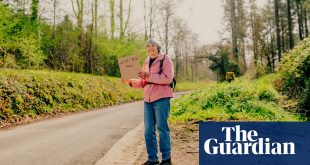I’m in Torremolinos. Yes, I know what you’re thinking – and you’d have a point. But I’m not here for the sun, cheap booze and a full English, although there are plentiful supplies of all the above. I’m here to relive my well-spent youth (albeit in a decidedly middle-aged fashion) at the 30th Rockin’ Race Jamboree, an international rockabilly festival that takes over Spain’s much-maligned resort for one wild weekend each February – and has been instrumental in boosting the town’s fortunes.
The Rockin’ Race is the creation of husband and wife, Guillermo Jiménez and Vivi Milla, from nearby Málaga, where they also run a record shop and label, both devoted to American music of the 50s and 60s. Like all the best festivals, it started out, back in 1994, as a gathering of friends sharing their love of the music. Three years later they had outgrown their venue in Málaga; the hunt for a new location took them the 10 miles along the coast to Torremolinos.
It wasn’t the obvious choice. In the 90s, London was the white-hot centre of Europe’s rockabilly scene, along with famously hedonistic weekenders at British coastal holiday camps. Spain barely featured on the rock’n’roll map, and some of its Costa del Sol seaside resorts were fading into decrepitude. But 30 years later, the rockabilly and vintage scene has exploded across the continent, and the Rockin’ Race Jamboree is one of its biggest festivals, attracting over 5,000 visitors and more than 40 bands and DJs from across the world.
It’s not just a highlight in the calendar of rock’n’roll fans, but also for the region’s tourism industry. The town’s mayor claims it brings a 40% boost to the local economy, and the event is now supported financially by the Andalusian and Torremolinos authorities, EU funds, Iberia Airline and the Costa del Sol tourist board. This is not an anomaly; other Spanish regions have also realised the value of supporting specialist music festivals as a way to boost off-season travel, including the mod/60s underground festival, The Euro Groovy Weekend in Gijón in January, High Rockabilly in Calafell in September, and the Funtastic Drácula Carnival in Benidorm in October/November – described as “three nights of demented garage punk”. As a British musician and former festival director, this level of support for popular music is staggering – and envy-inducing.
The injection of municipal funding hasn’t affected the vibe though – at the Rockin’ Race the grassroots remain strong, and it still feels like a giant party created by music lovers for their friends. During the day the main action takes place at a pool party and rooftop bar of the mid-century beachside Hotel La Barracuda, and the festival’s night-time venues have expanded to include the town’s Asturias Auditorium, and since last year, the “Paradiso”, a 1920s travelling wooden circus dancehall, complete with stained glass and original handpainted graphics. Accommodation is booked solid throughout the town months in advance. On Monday after the festival this year people were already booking for 2025 as they checked out of their hotels.
Festival-goers come from all over: Mexico, Japan, the US and across Europe. Same for the bands. Over the years, the Rockin’ Race has expanded beyond its rock’n’roll roots to take in swing, blues, R&B, honky tonk, 60s beat and garage. My highlights this year were the Surfrajettes, a female surf group from Toronto, and bluegrass band the Po’ Ramblin Boys, from Tennessee, who stole the show with a blistering, high-energy performance. The event’s official videographer, Chris Magee of Bopflix Films, has been documenting the Rockin’ Race each year, and says he’s watched it morph from a niche event into a phenomenon supported by the whole town.
During the weekend you can walk into the smallest backstreet cafe or grocery shop and they’ll be blasting out an obscure Sun Records B-side, while every taxi driver in town has curated his own rockin’ soundtrack. Ana, manager of the Buensol Apartments, located at the heart of the festival, is one of those who looks forward to the weekend. “When I first heard about a rock’n’roll festival coming to Torremolinos, I was a bit worried,” she said, “but they’re the most polite, friendly people we have all year, and they bring lots of money into the town. What more could you want?”
It is somehow fitting that mid-century glamour has returned to Torremolinos. The town’s tourism story is a chequered one. In the 50s it became a hotspot for stars seeking an alternative to the Côte d’Azur. Visits from Rita Hayworth, Graham Greene and Ava Gardner helped put a then rustic Andalusian fishing village on the map. In the 50s, a striking modernist hotel, El Pez Espada, was built on the beach, bringing more celebrities, including Frank Sinatra and Brigitte Bardot, while French visitors brought bikinis and topless sunbathing. The word was out. Torremolinos became known as a haven of louche bohemia, and in 1962, when two Londoners opened Tony’s, Spain’s first gay bar, it earned a further reputation as a safe destination for the queer community, despite homosexuality being illegal under Franco’s dictatorship.
Photograph: Wilf Doyle/Alamy
The money was pouring in from the Costa del Sol, and for a while the authorities were willing to turn a blind eye, but as the 60s raged on, and Torremolinos added hippies and drugs to its attractions, Franco could no longer tolerate the “degenerate” behaviour going on under his nose. In 1971 Tony’s was raided by gun-toting police. The bar was shut down, and the town’s foreign “undesirables” rounded up and deported to their home countries. The party was over.
after newsletter promotion
The subsequent boom and bust of Torremolinos is well documented in British tourism, and probably best summed up by Monty Python’s 1972 Travel Agent sketch which singled out the town as a byword for tawdry package tour destinations.
There are still plenty of sun-bleached laminated menus featuring images of egg and chips but Spanish seaside resorts are masters of reinvention, and Torremolinos has grand plans to follow in the footsteps of Málaga, Lanzarote and Magaluf, with a multimillion-euro regeneration scheme, much of it centred on celebrating the town’s decadent past and its growing popularity among LGBTQ+ tourists, who consider it the birthplace of Spain’s gay rights movement.
After decades in the wilderness, it seems the “degenerates” are back in favour in Torremolinos, and thanks in part to the Rockin’ Race, the good times are rolling again.
Rockin’ Race Jamboree is on 6-9 February 2025; weekend tickets cost €99 (day tickets also available), rockinrace.com
 Top Naija News: Nigerian News, Breaking News Nigeria and World News Top Naija News is a daily news publication in Nigeria, delivering the latest breaking news in Nigeria and around the world.
Top Naija News: Nigerian News, Breaking News Nigeria and World News Top Naija News is a daily news publication in Nigeria, delivering the latest breaking news in Nigeria and around the world.



